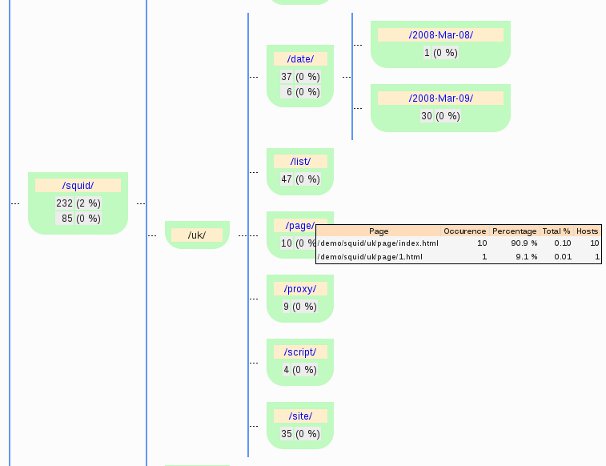The first section show you which HTML files are the most popular. The number of files can be altered in the configuration file or using the -t flag when running the scripts. Usually the first most successful page is your homepage and the framed pages relative to if any. You can exclude the HTML pages which load frames (pages which contains the tag <frameset> will be excluded). If you select the URL mapping, you'll have more readable stats. Instead of having a list of URL, you will able to view the name of the file found in the title tag of the HTML pages. If you have multiple title for differents pages, a number is displayed. The percentage is relative to the total number of HTML files.
Clicking on the link will allow you to view the page.
Full list is available.
|

|

|
| Graphical stats for a selected page | List of accesses for these page ordered by date |
The second part is a selection of files you would like to get more
informations. The URL file associated should be included in the
configuration file. You should not give too much files as this could
take age if they are too numerous. You should switch to the higher
precision level (which is 4) if you need to get accurate page stats
for all your HTML files.
Clicking on the link will open a HTML page which give you a graphic
showing the previous accesses to this page for a limited number of
days. Below a table is displayed with all accesses described with the
following informations : host who have download the page, the occurence
of being downloaded by this site from the beginning of the stats and
the date of last access.
If you choose to use your homepage HTML file, the graphs will show you the number of hosts visiting you day by day. Of course, if you have 100 hosts accessing your homepage, it doesn't mean you have 100 people visiting your website. Most could go away from your homepage...or stop because of a heavy homepage. In the first case, the session stats will show you the right number of people because you need to spend a few amount of time or read a few amount of HTML pages before being included as a visitor. In the second case, use the Document stats which will warm you about HTML files too big. Also, people can enter your website from another page than your homepage !
 List of pages read for the previous days
List of pages read for the previous days
Third section is the main page stats. To avoid downloading a huge file if you have lots of HTML pages, the stats page have been sorted by directories. If you select a directory, only HTML pages which belong will be displayed. The upper number is the occurence for the whole directory, including sub-directories, the lower number counts files only inside the directory. If you can click on a directory, it means there are some pages stats inside.

Pages are sorted by directories |
|

View accesses over the last few days |

Graphs are available for each HTML pages |
You will be able to view the accesses for each page for the last few
days. If the access number is displayed against a blue background, it
means that no increase or decrease have been detected from the
previous day. A red background indicates at least an one percent decrease and
a green ones indicates an one percent increase over the previous day.
If you select the URL mapping, you will be able to read the title of the
page instead of a raw URL. But URL is still available as you can click
on the link to check what is the page in case of unprecise title.
A graph is also available.

